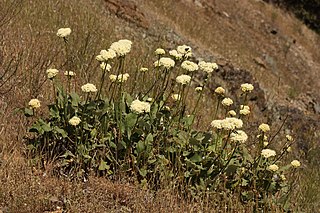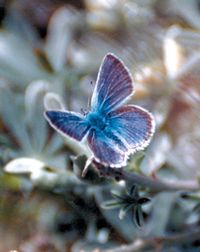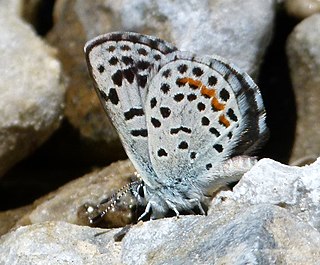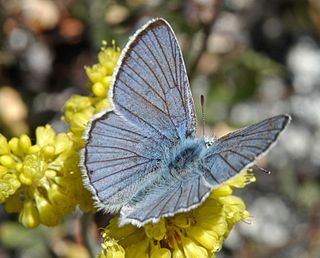
The El Segundo blue is an endangered species of butterfly. It is endemic to a small dune ecosystem in Southern California that used to be a community called Palisades del Rey, close to the Los Angeles International Airport (LAX).

The common blue butterfly or European common blue is a butterfly in the family Lycaenidae and subfamily Polyommatinae. The butterfly is found throughout the Palearctic. Butterflies in the Polyommatinae are collectively called blues, from the coloring of the wings. Common blue males usually have wings that are blue above with a black-brown border and a white fringe. The females are usually brown above with a blue dusting and orange spots.

Eriogonum is a genus of flowering plants in the family Polygonaceae. The genus is found in North America and is known as wild buckwheat. This is a highly species-rich genus, and indications are that active speciation is continuing. It includes some common wildflowers such as the California buckwheat.

Apodemia mormo is a principally Nearctic butterfly in the family Riodinidae. It is a particularly fascinating species for ecological and evolutionary research, as evidenced by its shifting taxonomic classifications. Conflicting observations of host plants utilized, distinctive morphologies, and a wide range of occupied habitats have prompted investigation into several potential subspecies. To date, two genetic studies have been done on A. mormo, with analysis revealing that disjunct populations are genetically and phenotypically distinct. These studies support a potential need for refined taxonomies, although a larger body of data is required to make clear decisions.

The Delhi Sands flower-loving fly is a subspecies of flower-loving fly, a member of the genus Rhaphiomidas in the Mydidae family. It was the first fly added to the Endangered Species List in the United States.

Eriogonum fasciculatum is a species of wild buckwheat known by the common names California buckwheat and flat-topped buckwheat. Characterized by small, white and pink flower clusters that give off a cottony effect, this species grows variably from a patchy mat to a wide shrub, with the flowers turning a rusty color after blooming. This plant is of great benefit across its various habitats, providing an important food resource for a diversity of insect and mammal species. It also provides numerous ecosystem services for humans, including erosion control, post-fire mitigation, increases in crop yields when planted in hedgerows, and high habitat restoration value.

The Mission blue is a blue or lycaenid butterfly subspecies native to the San Francisco Bay Area of the United States. The butterfly has been declared as endangered by the US federal government. It is a subspecies of Boisduval's blue.

Euphilotes is a genus of butterflies in the family Lycaenidae, which consists of a number of species found in western North America. Some of the species are endangered, such as the Smith's blue, Euphilotes enoptes smithi.

Eriogonum parvifolium is a species in the family Polygonaceae that occurs on dune formations in the coastal area of Central and Southern California. This evergreen shrub grows to a height of 30 to 100 centimeters with a spread of approximately the same dimension. This plant is an important host for a number of pollinating insects including certain endangered species. E. parvifolium occurs both on bluffs along the Pacific Ocean coast as well as Coastal Strand dunes formations, but is restricted to altitudes below 700 meters. In at least one instance within the Carbonera Creek watershed, it occurs farther inland in a Maritime Coast Range Ponderosa Pine forest. This shrub is also known by the common names dune buckwheat, coast buckwheat, cliff buckwheat, or seacliff buckwheat.

In biogeography, a native species is indigenous to a given region or ecosystem if its presence in that region is the result of only local natural evolution during history. The term is equivalent to the concept of indigenous or autochthonous species. A wild organism is known as an introduced species within the regions where it was anthropogenically introduced. If an introduced species causes substantial ecological, environmental, and/or economic damage, it may be regarded more specifically as an invasive species.

The Sand Mountain blue is a lycaenid butterfly of the "blue" subfamily that is only found around the Sand Mountain Recreation Area near Fallon, Nevada. It is a subspecies of the pallid blue.

Apodemia mormo langei, the Lange's metalmark butterfly, is an endangered North American butterfly. It is a subspecies of the Mormon metalmark and belongs to the family Riodinidae. The butterfly is endemic to California, where it is known from one strip of riverbank in the San Francisco Bay Area. A 2008 count estimated the total remaining population at 131 individuals. Since 2011, this number has dropped to about 25–30.

Eriogonum cinereum is a species of wild buckwheat known by the common names coastal buckwheat and ashyleaf buckwheat.

Eriogonum kennedyi is a species of wild buckwheat known by the common name Kennedy's buckwheat.

Callophrys dumetorum, the coastal green hairstreak, bramble green hairstreak, or bluish green hairstreak, is a butterfly of the family Lycaenidae. It is found in the United States in coastal California and rarely in inland California. Subspecies C. d. oregonensis is known as the Oregon green hairstreak.

Euphilotes rita, the rita blue or desert buckwheat blue, is a species of butterfly of the family Lycaenidae. It is found in Wyoming, Colorado, Arizona, New Mexico and northern Mexico. The species was first described by William Barnes and James Halliday McDunnough in 1916.

Euphilotes battoides, the square-spotted blue or buckwheat blue, is a species of butterfly of the family Lycaenidae.

Euphilotes pallescens, the pale blue, pallid blue or pallid dotted blue, is a species of butterfly of the family Lycaenidae. It is found in the United States in southeastern California, Nevada, southern Utah and northern Arizona.

Euphilotes ancilla, the Rocky Mountain dotted blue, is a species of butterfly of the family Lycaenidae. It is found from Washington south to California and southern Alberta and Saskatchewan south through the Rockies and high plains to Wyoming, Colorado, Utah, and northwestern New Mexico. The species was first described by William Barnes and James Halliday McDunnough in 1918.

The blue copper, also known as Lycaena heteronea, is an American butterfly that belongs to the gossamer-winged family. The butterfly is named so because of the bright blue hue of the upper side of the males' wings. Females are brown on their upper side. Both sexes are white with black spots on the underside of the wings. Blue coppers are seen on the west coast of the United States and the southwest region of Canada, particularly British Columbia and Alberta. The males are often confused with Boisduval’s blue, another species of butterfly. Blue coppers prefer to live in areas where species of Eriogonum are found. Blue copper larvae sometimes form mutualistic associations with Formica francoeuri, an ant species.





















